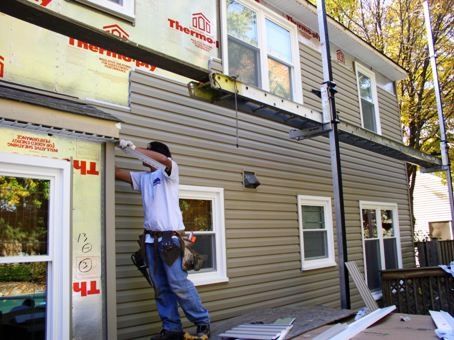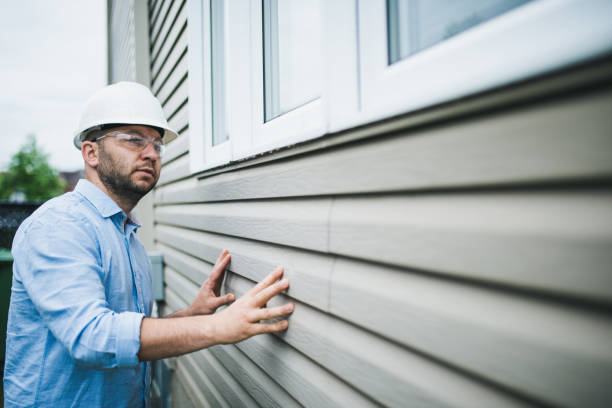The Crucial Overview to the Various Kinds of Siding and Their Distinct Benefits
In the world of home renovation, choosing the ideal siding is a crucial choice that influences both aesthetic appeal and practical efficiency. The selection of materials readily available, such as wood, vinyl, fiber cement, brick, and steel, each offer unique advantages that satisfy different requirements and choices. Comprehending these differences can considerably enhance the durability and value of a building - morris siding contractor. However, with numerous alternatives to consider, which house siding material really attracts attention for your particular job? Discovering these choices can lead to notified decisions that line up with both design and usefulness.
Timber Home Siding
Timber exterior siding, a prominent choice for household outsides, uses an ageless visual that combines natural beauty with structural stability. This exterior siding material is offered in different styles, consisting of clapboard, tiles, and board-and-batten, permitting property owners to tailor their appearance to match their style choices. Wood home siding is normally crafted from long lasting types such as cedar, redwood, or ache, which are understood for their strength and ability to hold up against ecological stressors.
One of the key benefits of timber house siding is its outstanding insulation homes, which can add to energy performance and reduced heating prices. Additionally, wood siding is biodegradable, making it an eco-friendly option when sourced sustainably. Normal maintenance, consisting of paint or discoloration, can extend its life-span and enhance its look, allowing property owners to preserve the all-natural charm of the wood.
However, potential downsides consist of susceptibility to pests, rot, and weather damages, demanding sufficient treatment and maintenance - morris siding contractor. In spite of these worries, when properly cared for, wood house siding can provide a gorgeous and durable remedy that enhances the character of a home while offering a cozy, inviting environment

Vinyl Siding
Vinyl siding has become a leading option for house owners looking for a low-maintenance outside alternative that combines resilience and cost. This functional material is crafted from polyvinyl chloride (PVC), making it resistant to different climate condition, including moisture and UV rays. Consequently, vinyl home siding does not warp, rot, or discolor, guaranteeing resilient aesthetic charm.
One of the primary benefits of vinyl home siding is its considerable range of designs and shades, permitting homeowners to attain the desired seek their building without the need for frequent repainting. In addition, vinyl exterior siding is very easy to set up, which can considerably minimize labor costs during building or restoration projects.
Vinyl exterior siding additionally contributes to energy performance. Several alternatives function insulation backing, which improves thermal performance, aiding to keep comfortable interior temperatures and potentially decreasing energy bills. Its smooth surface facilitates simple cleansing, requiring only periodic washing with a garden tube to remove dust and debris.
Fiber Cement Siding
Fiber concrete house siding has acquired traction among building contractors and homeowners alike because of its impressive combination of durability and visual convenience. Composed of a mix of cement, sand, and cellulose fibers, this home siding choice is crafted to endure severe weather conditions, including high winds, hefty rainfall, and temperature level variations, making it a long-lasting option for household exteriors.
Among the main benefits of fiber concrete house siding is its resistance to insects, such as termites, and its non-combustible nature, offering improved fire safety and security. morris siding contractor. Furthermore, it is readily available in a wide range of shades, structures, and designs, allowing property owners to attain their wanted visual without compromising performance
Another benefit is its reduced upkeep needs; fiber concrete siding generally needs paint or staining every 5-10 years, which is much less frequent than various other materials. Its long life adds to a lower general cost of ownership, as it minimizes the demand for frequent fixings or replacements.
Eventually, fiber concrete siding represents an outstanding investment for those seeking a durable, appealing, and flexible outside alternative, integrating both form and function to improve the home's visual top article charm.
Metal Home Siding
The allure of metal siding hinges on its durable resilience and modern visual allure, making it a preferred choice for modern design. Available in products such as light weight aluminum and steel, metal siding offers a series of shades and coatings, enabling homeowners to attain a tailored appearance that complements their layout vision.

Energy performance is one more considerable advantage, as numerous metal siding products are designed with insulation options that aid manage interior temperature levels. This can cause minimized energy costs over time. Additionally, steel house siding is often recyclable, making it an eco-friendly selection for sustainability-minded house owners.
The setup process for metal exterior siding can be fairly straightforward, resulting in a quicker turn-around time for building tasks. On the whole, metal exterior siding incorporates performance and style, making it a practical alternative for those seeking a enduring and aesthetically attractive outside surface.
Brick and Rock Exterior Siding
Block and rock siding attracts attention as an ageless choice that boosts the aesthetic beauty of any type of home. Known for their durability and reduced maintenance, these products offer an outstanding roi while boosting the residential or commercial property's visual allure. Offered in numerous colors, appearances, and patterns, brick and stone can be customized to suit varied building styles, from standard to modern.
One of the main benefits of block and stone exterior siding is their power performance. Both products possess natural protecting properties that help control interior temperature levels, possibly lowering cooling and heating expenses. Furthermore, they use premium fire resistance compared to other siding choices, contributing to improved security.
One more advantage is their long life. Block and rock can last for decades, frequently needing minimal upkeep beyond occasional cleaning. Unlike timber siding, they are invulnerable to bugs and rot, making certain a durable exterior that endures the components.
Final Thought
In summary, the option of home siding considerably influences a home's aesthetic allure, energy performance, and maintenance requirements. Each kind of exterior siding-- whether timber, vinyl, fiber block, cement, or steel and stone-- uses distinct check over here advantages tailored to different homeowner preferences and ecological conditions.
One of the main advantages of wood home siding is its excellent insulation properties, which can contribute to power efficiency and reduced heating expenses. In addition, wood home siding is eco-friendly, making it an ecologically pleasant Read Full Article option when sourced sustainably.One of the primary benefits of steel siding is its resistance to different ecological factors.Energy performance is another considerable benefit, as many metal home siding items are designed with insulation options that assist manage interior temperatures. Each type of exterior siding-- whether timber, plastic, fiber steel, brick, or concrete and stone-- supplies distinct advantages customized to numerous homeowner preferences and environmental conditions.